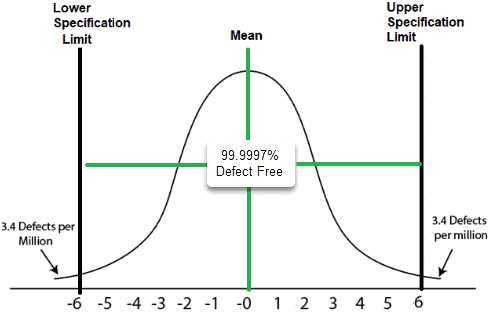What is Six Sigma (6σ)? Principles, Methodologies, Certification, PDF
Six Sigma is a quality-control methodology developed by American engineer Bill Smith while working at Motorola in 1986. The method uses data-driven analysis to limit mistakes or defects in a corporate or business process. The six sigma system is a method to work faster with fewer mistakes.
Nowadays, Six Sigma has developed into a more general business-management viewpoint, focused on meeting customer requirements, improving customer retention, and improving and sustaining products and services. Six Sigma applies to all types of industries. Many companies, including Motorola itself, offer Six Sigma training with special certifications carrying the names of white belt, yellow belt, green belt, and black belt.
Six Sigma methods look for improving manufacturing quality by identifying and eliminating the causes of defects and minimizing variance in manufacturing and business processes. Six Sigma does it by using experimental and statistical quality control management methods and by hiring Six Sigma experts. Each Six Sigma project follows a defined method and has specific quality targets, such as reducing pollution or increasing customer experience.
What you are going to learn?
Understanding of Six Sigma
In statistical analysis, the Greek letter sigma (σ) is used to stand for a standard deviation from the mean. It is basically a statistical benchmark all business tries to achieve. The business process, which is achieving six sigma produces less than 3.4 defects per 1 million parts, is considered efficient.
Let’s understand six sigma by this figure:

This straight line is the mean line, represents by µ= 0. The horizontal axis showing distance from the mean, denoted by the units of standard deviation which is represented as Sigma (σ). The upper and lower specification limits (USL and LSL) are at a distance of 6σ from the mean.
Even if the mean line were to move right or left by 1.5 standard deviations or 1.5 sigma, there will be still a safety cushion. If your process is behaving between 6 sigma, that means your upper and lower specification limit is on 6 sigma, then you will be able to produce less than 3.4 defects per 1 million parts, which is almost perfect and achievable in actual condition.
If I make a comparison between Three Sigma (3σ) and Six Sigma (6σ), we can see defects per million is 66,807 in the case of 3 sigma, and defects per million is only 3.4 with 6 sigma.
Six Sigma Methodologies
Six Sigma projects follow two project methodologies,
- Six Sigma DMAIC, &
- Six Sigma DMADV.
It derived each word of the name from the major steps in its process, but each has its own use.
Let’s breakdown Six Sigma DMAIC step-by-step:
- Define: Define the system. Identify the project objectives and all consumer deliverables.
- Measure: Measure key aspects of the current process, and understand performance.
- Analyze: Analyze the data to investigate and verify cause and effect of the differences. Determine root causes of any defects.
- Improve: Improve the current process based upon data analysis using techniques such as design of experiments, mistake proofing, and standard work to establish a new, future state process. Establish ways to eliminate defects and correct the process.
- Control: Control the future state process to ensure that they correct any deviations from the target before they result in defects. Manage future process performance.
We should use the DMAIC methodology when an existing product or service is not meeting customer needs or performing to its highest standards. It is used to correct an existing process.
Here is a step-by-step breakdown of Six Sigma DMADV:
The first three steps are identical to DMAIC.
- Define: Define the system. Identify the project objectives and all consumer deliverables.
- Measure: Measure key aspects of the current process, and understand performance.
- Analyze: Analyze the data to investigate and verify cause and effect of the differences. Determine root causes of any defects.
- Design: Design an improved alternative, create a process that meets customer needs and expectations.
- Verify: Verify the design, ensure process designed meets customer needs and performs adequately.
The DMADV methodology should be used when a business is developing a new product or service, or when using DMAIC for a current project or process fails.
Download What is Six Sigma PDF
What are the key principles of Six Sigma?
1. Focus on the Customer
The main goal of every business is to bring maximum payoff to the customer. In order to do that, a business needs to understand its customers, their needs, and what drives sales or establishes loyalty to its brand. This calls for settling the standard of quality as specified by what the customer or market demands.
2. Use data
Collect data to identify the specific problem area that is needed to be addressed or transformed. Businesses need to clearly describe the goals for data collection, including defining the data to be collected. After ensuring the accuracy of measurements, establish a standardized data collection system.
Find out if the data is helping to achieve the specified goals, whether the data needs to be refined, or additional information is collected. Identify the problem first. Then ask questions and find the root cause.
3. Improve continuously
Once the problem is analyzed, make changes to the process to get rid of deviation, thus removing defects. Remove the activities in the business process that does not add value to the customer. Businesses need to regularly take out the junk, bottlenecks from the process and improve the process continuously.
4. Involve people
Engage all stakeholders. Establish and follow a structured process where your team contributes and collaborates with the diverse expertise of their specific domain for problem-solving. Six Sigma processes can have a great impact on an organizational process, so the team has to be trained in the principles and methodologies used to create products or services.
5. Flexible and responsive work environment
The character of Six Sigma is a business transformation and change for betterment. When a faulty or inefficient process is eliminated, it calls for a change in the work practice and how employees approach it. The people and departments involved should be able to adapt to change with ease, so to facilitate this, they should design processes for quick and seamless adoption.
Six Sigma Levels or Six Sigma Certification
All Six Sigma processes are executed by the following:
- Six Sigma White Belts
- Six Sigma Yellow Belts
- Six Sigma Green Belts
- Six Sigma Black Belts
Sigma programs are overseen by a Six Sigma Master Black Belt.
Six Sigma White Belts
The white belt is the simplest stage where a newcomer can join. Here, they work with teams on problem-solving projects and understand the basic Six Sigma concepts.
Six Sigma Yellow Belts
In the yellow belt, the participant takes part as a project team member. They review process improvements and gain an understanding of the various methodologies used in 6 Sigma.
Six Sigma Green Belts
Six sigma green belt requires a minimum of three years of full-time employment, they should understand the tools and methodologies used for problem-solving. They have to help black belt projects in data collection and analysis, and lead Green Belt projects or teams.
Six Sigma Black Belt
A 6 Sigma Black belt should have work experience in the core knowledge areas and complete a minimum of two Six Sigma projects. Their role is to lead diverse teams in problem-solving projects and give training to project teams.
Six Sigma Master Black Belt
To reach the Master Black Belt level, the candidate must have received a Black Belt certification, have a minimum of five years of full-time employment, and they should complete a minimum of 10 Six Sigma projects, Have worked as an organization’s Six Sigma technologist, and internal business transformation advisor.
How to implement Six Sigma
Before implementing 6 Sigma within a process, the first step is to properly establish the case for a statistical method like 6σ, and its potential benefits to getting stakeholders within the process.
It’s crucial to set the expectation that being completely defect-free is not realistic. However, there are some best practices that can help to ensure the making of as much defect-free as possible.
Once the administration understands the potential behind Six Sigma, the following eight steps can help to implement a sigma project and ensure a clean rollout.
- Step 1: Motivate stakeholders by highlighting the problem of product quality losses.
- Step 2: Implement project management and get the required resources.
- Step 3: Educate team members on the Six Sigma management methodology.
- Step 4: Create a quality control chart and identify priorities.
- Step 5: Assign ownership for all team members involved.
- Step 6: Ensure measurement of the right metrics and indicators according to the required standard.
- Step 7: Perform a root cause analysis to understand the source of defect.
- Step 8: Control the program to ensure proper implementation and continuous improvement is happening.
This is a generalized implementing process, in actual these steps can vary according to types of products and services.
What is the importance of Six Sigma?
Six Sigma proponents maintain its business approach benefits include up to 50% process cost reduction, cycle-time improvement, less waste of materials, a better understanding of customer demands, increased customer satisfaction, value stream, and more trustworthy products and services.
Motorola holds the federal trademark for Six Sigma, and we generally acknowledge that Six Sigma can be costly to implement and can take several years before a company sees bottom-line results.
In 1995, General Electric CEO Jack Welch’s very public endorsement of Six Sigma helped businesses outside of manufacturing know how Six Sigma methodologies can improve customer satisfaction in any industry.







Pingback: What is Lean Six Sigma? Definitions, Principles, Benefits, 5 Certification Belts |A Comprehensive Review (PDF Included) - EDUCATIONLEAVES